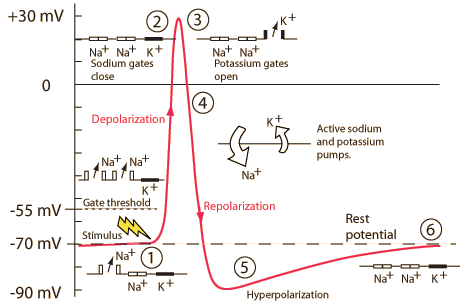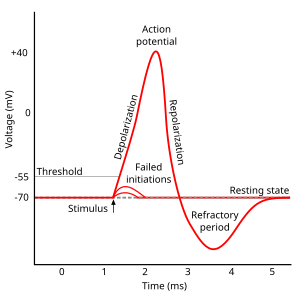- Action potential
- Action potential propagation
2017-09-18 15:09:08
Today's Topics
What is where
| Ion | [inside] | [outside] | Equilibrium V (+/-) | Diffusion |
|---|---|---|---|---|
| \(K^+\) |
What is where
| Ion | [inside] | [outside] | Equilibrium V (+/-) | Diffusion |
|---|---|---|---|---|
| \(K^+\) | high | low | - | outward |
What is where
| Ion | [inside] | [outside] | Equilibrium V (+/-) | Diffusion |
|---|---|---|---|---|
| \(K^+\) | high | low | - | outward |
| \(Na^+\) |
What is where
| Ion | [inside] | [outside] | Equilibrium V (+/-) | Diffusion |
|---|---|---|---|---|
| \(K^+\) | high | low | - | outward |
| \(Na^+\) | low | high | + | inward |
Why are \([Na^+]_{out}\) and \([K^+]_{in}\) high?
Why are \([Na^+]_{out}\) and \([K^+]_{in}\) high?
- Cell expends metabolic energy to create concentration gradients
The -60-80 mV resting potential
- A. Pulls \(Na^+\) in
- B. Pushes large organic anions out
The -60-80 mV resting potential
- A. Pulls \(Na^+\) in
- B. Pushes large organic anions out
Party On
- Annie (A-) was having a party.
- Used to date Nate (Na+), but now sees Karl (K+)
- Hired bouncers called
- "The Channels"
- Let Karl and friends in or out, keep Nate out
- Annie's friends (A-) and Karl's (K+) mostly inside
- Nate and friends (Na+) mostly outside
- Claudia (Cl-) tagging along
What happens if something changes?
- Easier for Karl [K+] to exit?
- Easier for Nate [Na+] to enter?
- Some action!
Action potential
Action potential
- Threshold of excitation
- Increase (rising phase/depolarization)
- Peak
- at positive voltage
- Decline (falling phase/repolarization)
- Return to resting potential (refractory period)
Action potential phases
| Phase | Neuron State |
|---|---|
| Rise to threshold | + input makes membrane potential more + |
| Rising phase | Voltage-gated Na+ channels open, Na+ enters |
| Peak | Voltage-gated Na+ channels close and deactivate; voltage-gated K+ channels open |
| Falling phase | K+ exits |
| Refractory period | Na+/K+ pump restores [Na+], [K+]; voltage-gated K+ channels close |

Refractory periods
- Absolute
- Cannot generate action potential (AP) no matter the size of the stimulus
- Voltage-gated Na+ channels inactivated, reactivate in time.
- Relative
- Can generate AP with larg(er) stimulus
- Some voltage-gated K+ channels still open
- Refractory periods put 'spaces' between APs
Generating APs
- Axon hillock
- Portion of soma adjacent to axon
- Integrates/sums input to soma
- Axon initial segment
- Umyelinated portion of axon adjacent to soma
- Voltage-gated Na+ and K+ channels exposed
- If sum of input to soma > threshold, voltage-gated Na+ channels open
Axon hillock, axon initial segment

Axon Hillock" by M.aljar3i - Own work. Licensed under CC BY-SA 3.0 via Commons
Driving force and equilibrium potential
- "Driving Force" on a given ion depends on its equilibrium potential.
- Driving force larger if membrane potential far from equilibrium potential for ion.
- Equilibrium potential
- Voltage that keeps current (inside/outside) concentrations the same
- Voltage membrane potential will approach if only that ion flows
Equilibrium potentials calculated under typical conditions
| Ion | [inside] | [outside] | Voltage |
|---|---|---|---|
| K+ | ~150 mM | ~4 mM | ~ -90 mV |
| Na+ | ~10 mM | ~140 mM | ~ +55-60 mV |
| Cl- | ~10 mM | ~110 mM | ~ - 65-80 mV |
Action potential and driving forces
Rising phase
- Membrane permeability to Na+ increases
- Na+ inflow
- Na+ driving force (toward +55 mV) dominant
Falling phase
- High \(Na^+\) permeability ends
- Permeability to K+ increases
- K+ outflow
- K+ driving force (toward -90 mV) dominant
AP propagation
- Propagation
- move down axon, away from soma, toward axon terminals.
- Unmyelinated axon
- Each segment "excites" the next
AP propagation is like
AP propagation
- Myelinated axon
- AP "jumps" between Nodes of Ranvier, saltatory conduction
- Nodes of Ranvier == unmyelinated sections of axon
- voltage-gated Na+, K+ channels exposed
- Current flows through myelinated segments
Question
- Why does AP flow in one direction, away from soma?
- Soma does not have (many) voltage-gated Na+ channels.
- Soma is not myelinated.
- Refractory periods mean polarization only in one direction.
Question
- Why does AP flow in one direction, away from soma?
- Soma does not have (many) voltage-gated Na+ channels.
- Soma is not myelinated.
- Refractory periods mean polarization only in one direction.
Conduction velocities
Information processing
- AP amplitudes don't vary (much)
- All or none
- AP frequency and timing vary
- Rate vs. timing codes
Next time…
- Review for Exam 1

